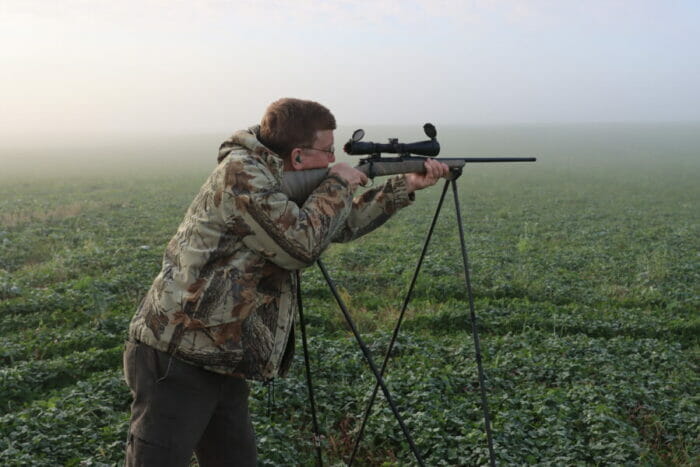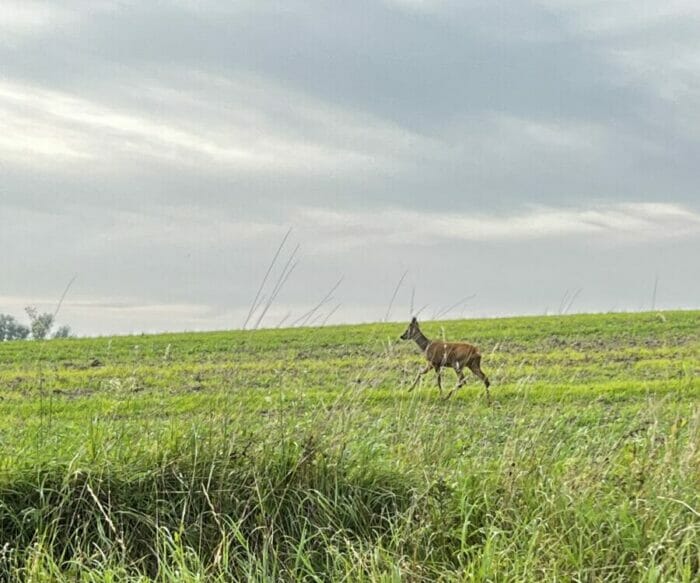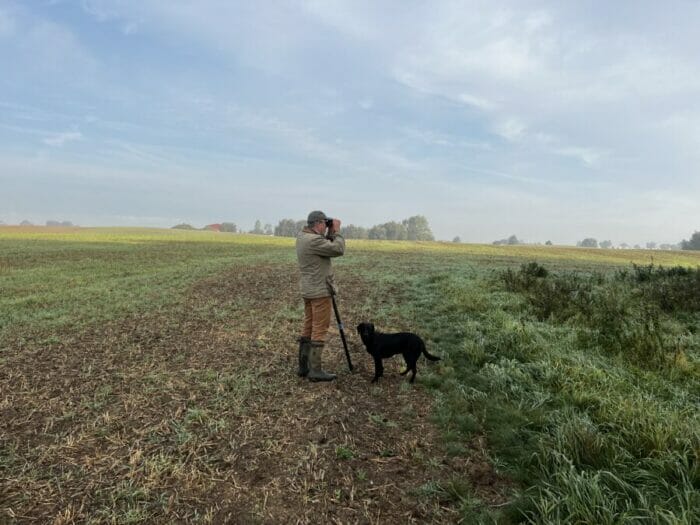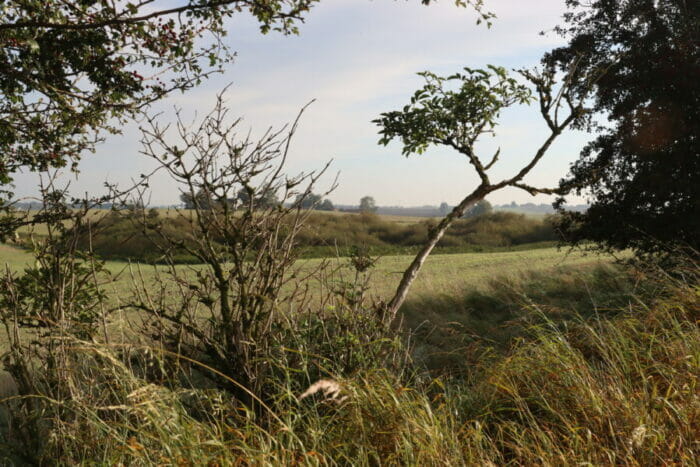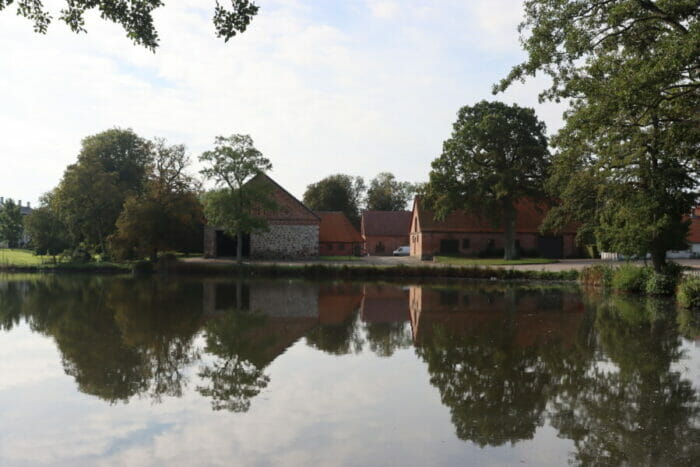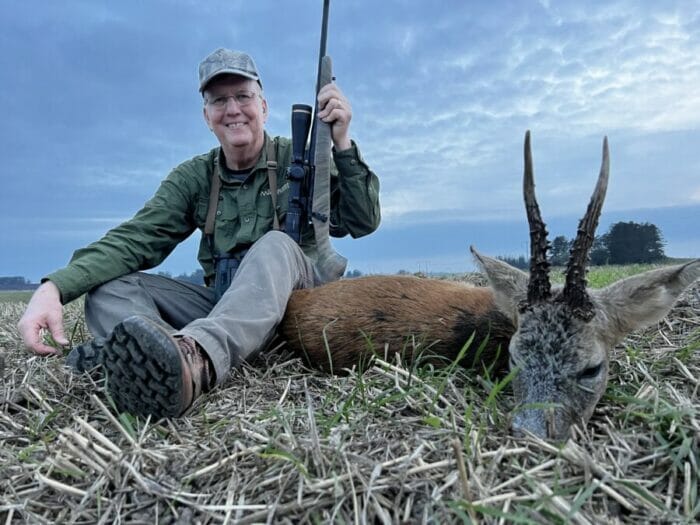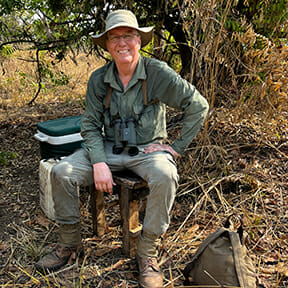A Dream Mordbock – Swedish Roebuck
“You know what you’ve gone and done, don’t you?” quipped my guide, Stefan Bengtsson. I wanted to answer, “Yep, I fulfilled another bucket list dream by collecting my first Roebuck.” Given the tone of Stefan’s rhetorical question, I assumed that would be the wrong answer, so I just shook my head and smiled, causing his response, “You’ve protected all the other breeding-age bucks from being murdered.”
O.K., now I was really in the weeds, more so than fifteen minutes earlier, when I lost track of where my Roebuck fell, angling 30o too far to the left, missing the dead buck by 50 yards. I blinked first in this verbal game of chicken, mumbling, “I give,” followed by, “How exactly did I act as a protector of Roebucks?” Stefan flipped the Roebuck onto its back, stating, “I’ll explain while we field dress this guy, but German hunters have a wonderful name, Mordbock, a.k.a. ‘Murder buck’ in English, for this type of buck.” I started to point out that Germans are well known for being comforting people but thought better of that, too.
Swedish Roebuck
The genesis of my hunt for a Swedish Roebuck began with approaching my buddy, Larry Weishuhn. Known by all as ‘Mr. Whitetail’, Larry’s hunting knowledge and contacts extend from east-to-west, north-to-south, and across all continents – well, I’m not sure about Antarctica, but you catch to where I’m drifting; he’s also one of the nicest human beings on the planet. These qualities guarantee when asked for references for outfitters; he would suggest ones at the top of their game and not horses’ patoots. Working on a book on the global impact of conservation through hunting, I needed a ‘European’ example or two and asked Larry for his recommendation. Without hesitating, he replied, “Scandinavian Pro Hunters run by a Swedish couple, Stefan Bengtsson and Sofia Hammarskjöld Bengtsson.”
I’ll be honest: Scandinavia did not come to mind when thinking of Europe. Instead, central-eastern European destinations such as Hungary and Poland were locales I assumed as primary. Stefan and Sofia do indeed organize hunts to such locations, but based in Sweden themselves, they have tons of properties within Scandinavia covering every species of game, whether native or those introduced hundreds to thousands of years ago. Some of the game available are Red Stag, Reindeer, Mouflon, Bison, Fallow deer, and the widely distributed and incredible little Roe deer, another of my ‘dream animals.’ Roe deer fossils indicate the appearance of this diminutive form in western Europe some one million years ago or so. Humans have thus been hunting Capreolus capreolus since migrating from the north, south, and east less than 12,000 years before the present. Like those earliest migrants, I, too, was intent on capturing a Roe deer of my own, but in my case, not just a meat source, but also a trophy buck.
My strong desire to pursue the roe deer mimics my passion for the Tiny Ten group of pygmy antelopes in Africa, the Brocket deer species in Central and South America, and the Pronghorn antelope of North America. I am fascinated with smaller herbivores with horns and antlers with symmetry and less ostentatious ornamentation. I find such animals beautiful and elegant at the same time. Before my hunt with Stefan and Sofia, I’d never seen a Roe deer except in photos and videos, but knew that a mature buck stood no more than three feet at the shoulder, weighing in at less than 70 pounds. Waiting for my very first look at a Roe deer in the wild, added to the mounting excitement as we headed out southeast from our early 14th-century hotel in Malmö, passing placenames evocative of Vikings like Vastra Ingelstad, Anderslöv, and Hönsinge with Jordberga ‘gods’ (a.k.a. ‘estate’) as our destination.
A total area of 5000+ acres of mostly rolling agricultural fields with scattered woodlots, ponds, and bogs, the Jordberga estate, plus the neighboring farm, are ideal habitats for the native Roe deer and Wild boar. They are also home to the beautifully spotted Fallow deer introduced in the mid-16th Century from the Middle East by the aristocracy for hunting in game parks and estates. According to Stefan, Roe deer thrive in free-range environments, not bordered by high fences. So, Jordberga represented a perfect setting for this Whitetail-esque species.
After checking the 4-15x VX-5HD Leupold optic on my pet rifle, one of Kerry and Carol O’Day’s MG-Arms Ultralights in 7mm Remington Magnum, Stefan and I headed across one of the recently harvested wheat fields in his CAN-AM Traxster. Short of the rise, we parked, slipped on packs, grabbed my 4StableSticks rest and rifle, creeping slowly toward the crest. Topping the first rise, we caught sight of a doe and her two half-grown young lying down amongst the plowed rows and new growth. We slowly knelt and studied the surrounding area for other deer looking for a buck. Spotting another pair of Roe deer, Stefan immediately knew the deer on the right was a buck, and the one on the left was another doe. As usual, my search image wasn’t ‘in’ this early on, so I searched in vain for either Roe deer until whispered directions from my guide honed my binocular into the right area. I could see that the deer on the right did indeed have some horns projecting up between his ears, but since this was only the fourth and fifth Roe deer I’d ever seen in the wild, and the first buck, I had no clue whether he was young or mature, big or small.
Stefan and I spent a wonderful 20+ minutes staring through our binoculars at the browsing animals before my guide announced his decision to pass on the Roebuck. “I can’t see his antlers as well as I would like because of the background, but I think he may be young” was his diagnosis. Little did we know we would be back in the same area in 11 hours, with 20 minutes of shootable light left, staring at the same buck at 220 yards, me through the riflescope, Stefan next to me through his binocular/rangefinder, realizing he was a magnificent trophy, and not sure he would give us a chance.
Slowly creeping away from the crest, we circled to the right, making our way toward another copse of hardwoods and associated bushes with undulating fields disappearing into the distance on the other side. We both froze in our tracks when yet another group of does and young came into view on the other side of a knoll, bedded down in a tight cluster. Fortunately, their heads faced away from us, and they did not spot us as we shuffled our feet backward, causing them to disappear again behind the low rise slowly. Sliding sideways, we descended the low slope we’d been climbing, mindful of the pairs and threesomes of Roe deer scattered across the landscape.
Finally reaching the tree line, we slowly edged around the corner, spying another group of Roe deer, this one including a very young buck staring in our direction from a mere 50 yards. Thankfully, once again, the wind was blowing back our eyelashes, and neither the buck nor the two does accompanying him noticed the two-legged intruders. Easing into a position on the other end of the strip of trees, we began glassing the next island of vegetation, where Stefan had spotted a mature Roebuck a few days earlier. After 30 minutes, Stefan asked me if I minded staying there, continuing the glassing, while he brought the Traxster over. I asked what to do if a Roebuck appeared. “Shoot him if he is big!” he said with a grin. I reminded him I was a novice at this, but I’d give it a try. As I watched the distant copse edge, I knew that a buck would have to look like a mature mule deer before I would take a shot.
Ten minutes after Stefan disappeared over the nearby rise, a series of clatters and thuds sounded from my left, causing me to rotate left. The sounds came from a Roe deer doe, followed closely by a buck. The pair hesitated as I brought the rifle onto my StableSticks, looking at their backtrail. The buck’s antlers looked long and beautiful in my scope, but I noticed the lack of secondary tines. Was he young, without the years necessary for growing a full rack? Was he ancient, having lost the ability to produce extra tines, like a whitetail buck who reaches the age when antler growth diminishes? I hesitated with the crosshairs resting on the shoulder of the animal standing a mere 70 yards away. I never put pressure on the trigger, knowing that I might make a terrible mistake, taking a young animal before they passed their reproductive sweet spot. It was thrilling to watch the twitching noses of the doe and buck, with ears pointed back to whatever startled them from their beds or browsing. I didn’t need the shot for completion.
I couldn’t wait for Stefan’s return. I wanted to relive the close encounter with the species I dreamt of since I saw photos in hunting magazines and scientific treatises in the 1970s. When he drove slowly to a stop, I grinned and recounted the episode just past. “Yep, I am the one who pushed them off the island of vegetation where they browsed,” Stefan related. “That was the buck and doe we watched earlier. I was wrong about him. He is a beautiful trophy; he is old, and we should have taken him when we had the chance.” I told him I’d stood rock solid with my sights on his shoulder but did not know if he was mature. Stefan commiserated and assured me mine was the right decision. “Better to let him walk away than make a mistake and shoot a youngster. That’s the height of conservation-through-hunting you are always writing and talking about, right?” I agreed, of course, but I still wanted to kick myself for being naïve about what constituted a trophy, Roebuck.
Third Times a Charm?
We took a break with a VERY filling lunch consisting of Rabiff (Swedish Steak Tartare) for Stefan and Sofia, who joined us after spending the morning scouting another property for Roe deer and a Veal Schnitzel for me. I was glad when we were again in the Jordberga gods agricultural fields, heading out on foot, leaving the Traxster to wait patiently for our return. Though we walked and glassed a vast territory, the Roe deer were out of sight in the trees and thick vegetation on the knolls and near the ponds scattered around the estate. After several hours, we found ourselves again bumping along the track leading into the vast fields where we had twice spotted the old buck.
Being pessimistic of our chances of seeing him for a third time in one day, Stefan’s pointing and sudden veering of the Traxster down a slope to the left of the track, accompanied by his urgent whisper, “Did you see the three deer on the far slope? I am positive one of them was the buck from this morning”, took me by complete surprise. Again, amazed by the eyesight acuity of a guide, I prepared the backpack sitting in my lap while gripping the gun tightly between my knees as we bounced over the clods and small rocks littering the plowed field. Stefan headed toward the opposite side of a larger-than-normal tree atoll that would screen our movements from the Roe deer. Parking near the top end, we hopped out of the Traxster’s cab, donned our packs, and grabbed the shooting rest and rifle. Instead of skirting around the tree line, Stefan opted for a more direct route straight through the forest that reminded me of an Oregon coastal rainforest in the density of its vegetation. I had to be careful not to end up hanging from a tree branch through a pack strap as I bent and weaved my way forward. Finally reaching the other side, we carefully exited a slow step at a time until we could see the rightmost deer in the group of four, a bedded doe on the far right of the group. Stefan pointed to the base of an electrical pole about 100 yards to our front, indicating that was the site to reach for our stand.
I followed directly behind my guide as he carefully began to climb the slope, trying as much as possible to place each of my quiet-soled boots into his footprints. We reached our destination at 6:20, with sunset around 20 minutes later, giving us nearly one hour of shooting light. This should have been plenty of time, but for one problem: the buck and two of the three does lay on the ground chewing their cud. Even at the 200-meter (~220 yards) distance Stefan and his rangefinder called out, the shot was makeable on the two bedded does because they were perched on top of small hillocks. On the other hand, the buck was lying in a slight depression, providing about two inches of side as an aiming point unless, of course, I wanted to sever his head from his body by shooting him in the neck; neither of those options was attractive. So, we opted to wait.
After 30 minutes of me peering through the Leupold optics, turned to its full 15x, Stefan whispered that we had 20 minutes of legal shooting time left. Legal or not, the autumn light in this northern latitude was fading fast. “I can move back to the copse of trees and come out behind the animals and try to push them your way, or I can whistle and see if I can get the buck to stand,” whispered my guide. I thought we would run out of time, even if the animals didn’t explode in the wrong direction if Stefan tried pushing them my way. I opted for door #2.
With Stefan’s first whistle, the buck tensed, eyes and ears searching for the source of the unnatural sound. The second whistle was more substantial and more piercing. The buck stood and crouched slightly, preparing a bound to propel him out of my field of vision. The trigger squeeze seemed to happen on autopilot. Because of MG-Arms’ excellent muzzle brake design, there was little barrel lift, allowing me to see the buck topple over the small rise behind him, with legs kicking weakly for only a moment and then going still. Out of habit, I’d fed another cartridge into the chamber, placing the sights onto the little of the buck still visible. Stefan spoke aloud for the first time in over an hour, taking off his hat and smiling broadly, extending his hand and stating, “Fantastic shot!”
Trying to beat the impending darkness, Stefan turned and returned to the vehicle, sending me across to where the trophy buck rested. On reaching the diminutive animal, I knelt and, as usual, thanked him for his life, given for the rich memories of the hunt and food for many meals. I then looked at the wonderful antlers – two long spikes covered with perlations (bumpy outgrowths) starting at the top of the head and ending halfway to the tips. With a grey muzzle, scant hair on the neck and shoulders, and teeth worn down to near the gumline, the age and character of the trophy were terrific.
So, what makes my trophy a Mordbock? Stefan explained as he quickly removed organs and pooled blood from the little animal. “Your Roebuck, at 7-8 years of age, is near the end of his life and his ability to produce offspring. Yes, he has beautiful horns with stunning character. Still, his lack of secondary prongs in front of his main spikes would make him lethal in the violent rutting battles, with his sharp, long, stiletto-like antlers easily penetrating the vitals of other combatants. Hence a ‘Mordbock,’ and a trophy German hunters would give their right arm to have hanging on their wall.”
Maybe having the surname Arnold – made up of Germanic components meaning ‘eagle’ and ‘brightness’ – explains my feeling the same.
With over 30 years of hunting experience, Scandinavian Pro Hunters offers hunts in Sweden, Norway, Greenland, Finland, Denmark, England, and Scotland. Whether big game, wing shooting, fishing, or trophy birds, they offer experiences custom-tailored to the individual.
Mike Arnold has been a life-long hunter. The Hunter’s Horn blew very early for him. From the age of five, Mike has spent months each year pursuing game animals – from quail and rabbits behind his parents’ house, to kudu and leopard in Africa, and Brocket deer in Mexico. Mike’s articles include feature pieces in Sports Afield, Hunter’s Horn, Safari Magazine, and African Hunting Gazette. Mike also produced two TEDx presentations on the topic of conservation-through-trophy-hunting. You can find links to many of his articles and his Blog here.
Mike is also a Professor and the Head of the Department of Genetics at the University of Georgia. He works in conservation biology and is the author of the 2022 book, BRINGING BACK THE LIONS: International Hunters, Local Tribespeople, and the Miraculous Rescue of a Doomed Ecosystem in Mozambique. Mike’s book is available for purchase at bringingbackthelions.com, Amazon and local bookstores.

